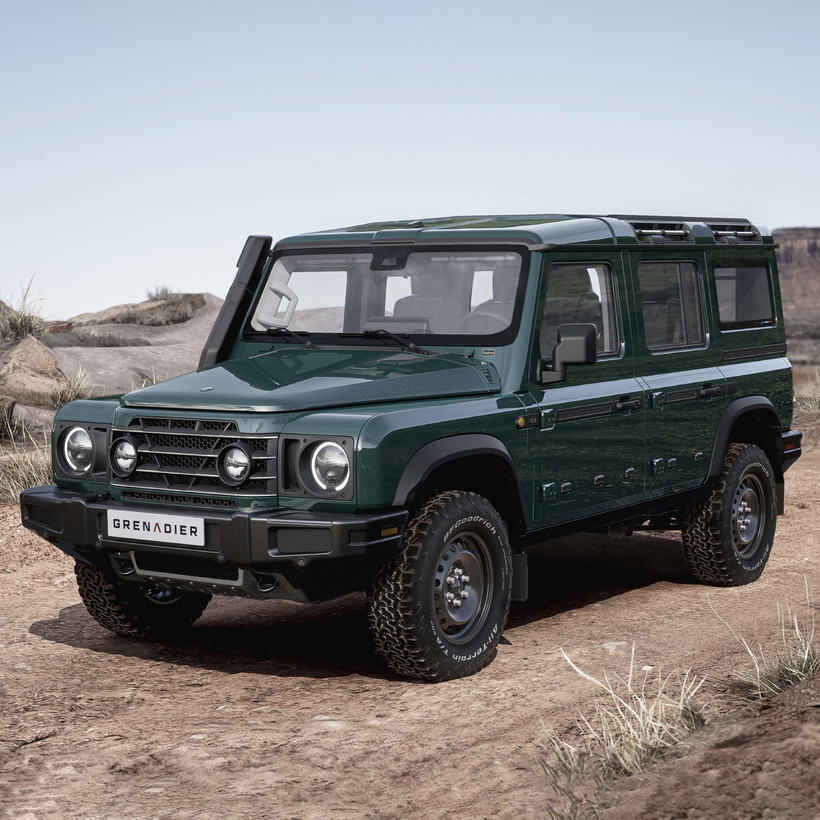With all the opprobrium getting deposited onto Elon Musk’s doorstep, it’s easy to forget that he’s hardly the first car-maker with objectionable views. Looking for shared values or any sort of moral clarity from an auto tycoon is and has always been a fruitless endeavor. From the reckless and rapacious founding days of the automobile business, with its colorful grifters and copious con artists, to many legacy car-makers’ relationships with the Third Reich and the industry’s almost universal opposition to safety and emissions regulation, disreputableness is a common thread. We could get into wholesale offshoring and the contemporary de-unionization movement and the tens of millions of dollars in political donations lavished upon Donald Trump and numerous election-denying congresspeople, but we won’t.
Which is to say that when we tell you the story of the Ineos Grenadier and Ineos’s founder and controlling shareholder, Jim Ratcliffe, you’d do well to remember that a car-maker’s priority is almost always selling cars as profitably as possible.
Born in a council house, Ratcliffe is today England’s second-richest man, having spun a Belgian oil refinery he purchased in 1998 into a chemical empire. Though he was trained as an engineer, with a brief stop at BP and an even briefer one (three days) at Esso—Britain’s ExxonMobil—private equity eventually proved Ratcliffe’s preferred métier. He bargain-hunted the type of small, chemical-producing properties with which oil companies had grown uncomfortable, making himself a pile of money in the process.

Under his closely held umbrella, Ineos, Ratcliffe has collected 30 companies that have a presence in 32 countries and annual revenues totaling $55 billion. Among the parent company’s holdings is the start-up Ineos Automotive, makers of the Grenadier, a rugged, four-door four-by-four first released in 2022—newly on sale in America—that AIR MAIL has just sampled.
The Grenadier is a tall five-seater with full-time four-wheel drive and optional panoramic windows in its roof. It is also available as a four-door pickup called the Grenadier Quartermaster. Both are very much in the vein of the endearing but notoriously crude Land Rover Defender, which launched in 1948 and remained in production through 2016.
The Grenadier is said to be a passion project for Ratcliffe, who named the truck after his favorite antique pub in London’s Belgravia, which he liked so much that he bought it. (As an even more recent measure of his appetite for owning all things British, in 2024 Ineos acquired a controlling share in the Manchester United soccer club. In 2017, Ratcliffe bought Belstaff, a 100-year-old British maker of waxed cotton jackets.)

In his plentiful spare time, Ratcliffe bought a cycling team, which naturally he renamed the Ineos Grenadiers, and which won the 2019 Tour de France. In addition, he controls a third of the Mercedes Formula 1 team, as well as the Swiss Lausanne-Sport soccer club. Ineos sponsors several rugby teams, too, including New Zealand’s legendary All Blacks, a star Commonwealth team that recently sued Ineos for failing to make sponsorship payments. Ineos settled the case a few weeks back, initially blaming “extreme carbon taxes,” which it claimed have led to the “deindustrialization of Europe.”
So the picture sounds rosy on the one hand—the story of a man at peace with owning everything that interests him. But profits have shrunk rapidly of late, and Ineos is having a tough time. Lawsuits continue to mount, which is unsurprising, as much of the company’s profits derive from the manufacture of ethylene, a component used in the manufacture of plastics that is derived from natural gas and fracking. Among other environmental hazards, carbon-neutral they’re not.
Back to cars. An oft-professed love for the outdoors and motoring led Ratcliffe to publicly mourn the passing of the Defender, a single model that, though updated through the years, carried on for well over half a century. Its replacement was a much more comfortable new take on the Defender, launched by its makers, Jaguar Land Rover, or J.L.R., late in 2019. Blessed with dramatically superior on-road manners to its spartan off-road predecessor, it also sold much better.

Ratcliffe was certain, though, that J.L.R., owned by India’s Tata Motors, was screwing up colossally by offering a more cosseting vehicle and leaving an icon forever behind. The traffic jam of jacked-up, old-school Defenders one sees on the road from Water Mill to East Hampton—each one costing as much as $250,000—attests to the demand for the original formula, even if that formula did not call for aftermarket “lift kits” and the absurdly large wheels and tires favored by today’s beachcombing poseurs.
Ratcliffe was so sure of the old model’s appeal that he offered to buy the Defender’s tooling from J.L.R. with plans to market a modestly updated version, which he proposed to build at a new factory in Wales. When the corporate response came back (“Hell, no!”), Ratcliffe decided to build what he had in mind anyway. After seeing how much his new model looked like a Defender, Land Rover’s defenders sued—and lost, before the U.K.’s Intellectual Property Office. On appeal, a U.K. court found that, over 68 years, J.L.R. had somehow failed to trademark the shape.
So Ratcliffe resumed production of the Grenadier. The staunch Brexiteer promised that the new S.U.V. would create British jobs, saying, “The decision to build in the U.K. is a significant expression of confidence in British manufacturing, which has always been at the heart of what INEOS stands for.” Ironically, he wound up building the car in the heart of E.U. country instead, in a Smart-car factory formerly owned by Mercedes in Alsace-Lorraine.
The Grenadier may not be enough to save the parent company, Ineos, from having to sell some of its component parts, but there’s no doubt the car is registering with the public. I see them all over my little town, along the western banks of the lower reaches of the Hudson, driven by women out shopping or off on a school run. Forget hunters and fishermen—this is the sweet spot in the market, abetted by the relatively inexpensive (accent on relatively) price of admission.
Dealers are scarce so far (though more are on the way), and Trump’s hated tariffs—currently reduced to 25 percent with the possibility of going higher, again—have had their effect on pricing. Though much of the industry is tiptoeing around in their public comments to avoid raising the ire of the Great Oz, the company announced in a refreshingly tart press release that it would be “shielding” Americans from Trump’s tariffs: “We want to provide our U.S. Grenadier customers with clarity in a world of change and uncertainty.”

So, with a starting price of just over $78,900, the Grenadier remains in the ballpark of the new Defender, Ford Broncos, and upscale Jeeps. More than 20,000 have been sold, which counts as pretty successful for a start-up’s first offering—though the grudge match with Land Rover and its supposedly (but not really) sissified Defender is not over, with Ineos placing ads and buying billboard space to juxtapose a mud-splattered Grenadier with a spotless Land Rover. And if that wasn’t in your face enough, they’ve taken to parking right in front of Land Rover dealerships, hoping to turn Defender foot traffic into conquest buyers.
To see for myself, I recently drove a Grenadier to Tampa by way of Durham, Montgomery, and New Orleans. Not off-road, I should clarify, but on-road, which is the way most will be driven.
Though it’s clearly best suited to the ranch, the dirt trail, and the rocky road to the sportsmen’s lodge, with its BMW turbocharged six-cylinder engine and eight-speed automatic transmission, the Grenadier drove and rode surprisingly well, reliably traversing 2,500 miles of highway, urban traffic, and suburban sprawl without excessive discomfort.
Steering is power-assisted but slow, with more than four turns lock to lock—said to be an advantage off-road. One learns to compensate for the vehicle’s unwillingness to self-center, an initially alarming characteristic. Fuel economy (around 17 m.p.g.) was nothing to write home about, though sadly that’s typical of this class of machinery.
Still, the Grenadier seemed well made, people admired it everywhere we went, and it happily tackled what seems to have become the average speed in the slow lane of our newly liberated society: 75 m.p.h. Expect to see a Grenadier soon in a grocery store parking lot near you.
Jamie Kitman is a car columnist at AIR MAIL


